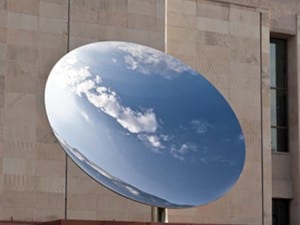It is difficult to label American artist Kay Rosen (b. 1943) as a text-artist alone. As she herself pinpoints in a recent interview, her creations feel directed by a “perception of language as object-like” (Rosen, Kay, In Conversation with Kay Rosen by Vassilious Doupas, 2014); hence, their foremost affect is manifest via their spatiality and visual composition. In that sense, she seems more of a sculptor working with our linguistic and conceptual perceptions. Everyday words gain new resonance, meaning and a playful self-reflexivity in her large-scale text paintings. Everything from layout to choice of colour generates a deliberate, and deceptively simple, tension between the physical shapes before you and the associations your mind cannot but immediately assign them.
Istanbul’s Galeri Zilberman small but effective exhibition of Rosen’s work is well-timed; particularly so because Rosen’s close following of Istanbul’s Gezi Park protests of summer 2013 has provided the inspiration for the centrepiece to the exhibition one year on. This new site-specific wall painting, Raze Raise (2014), looming over the room at 125 x 1250cm, is a considered distillation of the dual sense of creative social cohesion and unfortunate violence that accompanied those month-long Istanbul demonstrations. With “Raze” sprawling and “Raise” elongated, which comes first or which carries the greater visual impact remains in constant flux; this interrelation, Rosen explains, reflects how the two words become “linguistic proxies for actual structures […] the cycles of change [Istanbul] has passed through over the centuries.” (Rosen, 2014).
This (re)representing of the word through careful but minimal manipulation remains consistent throughout the rest of the exhibition. With an academic background in linguistics, it is no surprise Rosen’s vision is quite deconstructionist. Indeed, her art focused most intensively on language from the 80’s onwards, a period of high popularity for post-structuralist critique in the French and Anglo-American academy. Yet Rosen’s words are commonplace, ordinary: the intellectual facet to her conceptual rigour does not impose itself on the viewer. It is secondary to the pleasure of encountering a visual-linguistic wordplay, as in the amusing Caravan (2002), where the second “A” is a different tone of blue, thus splitting the word into three and conjuring three different vehicles in the mind even as the eye reads one.
Her work has a fondness of puns, bold shapes and a willingness to undermine its own authority so as to make its point about language. The concepts do not always require you to pick up on the syntactical or grammatical to realise the wordplay – mirroring, rearranging, varying size or even pigmentation, as in the literally gradated painting Gradated (2007), are utilised equally effectively. Although the question of the individual works’ universal accessibility remains, as is the case with all expression reliant on one particular language and its linguistic practices, Rosen’s work strongly continues its thirty-odd years of encouraging a critical approach towards representation, communication, and the public and private codes embedded in language.
Kay Rosen, until 26 July, Galeri Zilberman, İstiklal Cad. No.163 Mısır Apartmanı K.3 D.10 Beyoğlu / Istanbul
Sarah Jilani
Credits
1. Kay Rosen, KR_6, Caravan, Enamel sign paint on canvas, 38.1×76.2 cm.
Follow us on Twitter @AestheticaMag for the latest news in contemporary art and culture.





